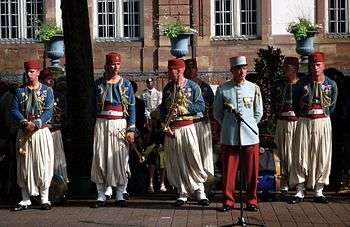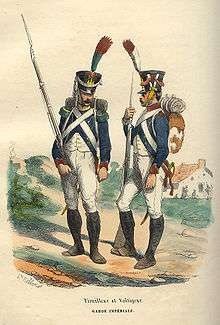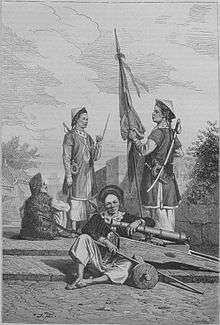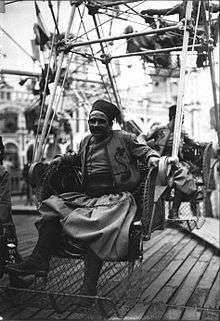Tirailleur

Tirailleur literally means a shooting skirmisher in French from tir—shot.
The term dates back to the Napoleonic period where it was used to designate light infantry trained to skirmish ahead of the main columns. Subsequently "tirailleurs" was used by the French Army as a designation for infantry recruited in the French colonial territories during the 19th and 20th centuries or for metropolitan units serving in a light infantry role.
The French army currently maintains one tirailleur regiment, the 1er régiment de tirailleurs. This regiment was known as the 170th infantry regiment between 1964 and 1994. Prior to 1964, it was known as the 7e régiment de tirailleurs algériens, but changed its name after being moved to France as a result of Algerian independence.
History
Napoleonic period

In the wars of the French Revolutionary and Napoleonic periods the designation "tirailleur" was a French military term used at first to refer generically to light infantry skirmishers. The first regiments of Tirailleurs so-called were part of the Imperial Guard of Napoleon I. By the fall of the Empire, some 16 regiments had been created. The Guard Tirailleurs were usually grouped as part of the Young Guard, along with their sister Voltigeur regiments. The Guard Tirailleur regiments were disbanded during the reorganization of the French Army in 1814 by the new royal government. On 28 March 1815, during Napoleon I's short-lived return to power (the Hundred Days), Regiments 1-8 of the Guard Tirailleurs were officially re-raised. Only the 1st and 3rd Regiments actually took the field for the Waterloo campaign. All regiments of Imperial Guard Tirailleurs (along with the rest of the Guard) were disbanded following the Emperor's second abdication.
Colonial period
Origins
The first tirailleurs employed in French North Africa were a metropolitan light infantry unit — the 1er bataillon de tirailleurs de Vincennes which disembarked in Algiers in early 1840. This unit subsequently became the chasseurs d'Orléans but the title of tirailleurs was allocated the next year to newly raised regiments of indigenous Algerian infantry recruited from the Arab and Berber communities.[1]
Algerian, Tunisian and Moroccan tirailleurs
The tirailleurs from Algeria subsequently served in the Crimean War, the Second Italian War of Independence, the French intervention in Mexico and the Franco-Prussian War (1870), as well as in French colonial campaigns in Tunisia, Indochina, Morocco, Madagascar and Algeria itself. During the Crimean War the Algerian tirailleurs acquired the nickname of "Turcos" (Turks) by which they were widely known over the next hundred years. The name reportedly arose from comparisons between the Algerian troops and the Turkish allies serving alongside the French and British forces at the siege of Sebastopol.[2]
First raised in 1841 as battalions of tirailleurs indigenes, the locally recruited Algerian infantry were organised into three regiments of Algerian Tirailleurs by a decree dated 10 October 1855.[3] The number of such units fluctuated over the next hundred years until in the early 1960s eight regiments of tirailleurs plus a number of independent battalions remained in French service
In 1884, the 4th Regiment of Tirailleurs was created in Tunisia. Except for minor distinctions of insignia and uniform (their numbering was based on the figure "4" and its multiples, plus light blue tombeaus or false pockets on their full dress zouave jackets) the Tunisian tirailleurs regiments had the same appearance as their Algerian counterparts.[4] It was only in 1921 that the French government decided to name them officially "Tunisian Tirailleurs Regiments".
In 1914, during World War I, the 1st Regiment of Moroccan Tirailleurs was created. At the end of the period of French rule in 1956 six regiments of Moroccan tirailleurs were still in existence.
The recruitment of Muslim tirailleurs was mainly voluntary, although a selective form of conscription was introduced in Algeria in 1913 and continued until the end of French rule in North Africa. The proportion of French European (both metropolitan and pied-noir settlers) to Maghrébin (North African) personnel had risen to about 30% by the end of World War II, as the tirailleur units became increasingly mechanized.

Senegalese tirailleurs

France made extensive use of tirailleurs in its colonial campaigns. The most numerous of these, after the "tirailleurs algériens" noted above, were the "tirailleurs sénégalais" (who were recruited from all of the French possessions in West and Central Africa). Both played an important role in the occupation of Morocco (1908–14) as well as in the Rif War of the 1920s.[5]


Tirailleur regiments from other French possessions
Before and during World War II (1939–45), tirailleurs were recruited from the Maghreb (Algerian, Moroccans, and Tunisians), from French West Africa and Madagascar (tirailleurs Malgaches).
Tirailleurs Indochinois
Regiments were recruited from the regions of French Indochina: Annam, Tonkin, and Cambodia. The regiments were named after the territory in which they were recruited. Thus "tirailleurs Annamites", "tirailleurs Tonkinois" and "tirailleurs Cambodgiens".
World War I
During World War I (1914–18) tirailleurs from North African territories served on the Western Front as well as at Gallipoli, incurring heavy losses. The Great Mosque of Paris was constructed afterwards in honour of the Muslim tirailleurs who had fought for France.
World War II and subsequent campaigns
Tirailleurs from North and Central Africa fought with distinction in Europe during World War II, notably in the Italian campaign. The Indo-Chinese tirailleur regiments were disbanded following the Japanese coups against the French colonial administration in March 1945. Algerian, Moroccan and Senegalese tirailleurs served in Indo-China until the fall of Dien Bien Phu and subsequently as part of the French forces during the Algerian War of Independence (1954–62). Even after the French withdrawal from Indochina, a unit of mostly Vietnamese tirailleurs ("le Commando d'Extreme Orient Dam San") continued to serve with the French Army in Algeria until 1960.
Disbanding of the tirailleur regiments
Most of the tirailleur regiments were disbanded as French colonies and protectorates achieved independence between 1956 and 1962. In Morocco, Tunisia and the new African states the majority of serving tirailleurs transferred direct from the French service to their new national armies. This was not the case in Algeria where locally recruited tirailleurs who remained loyal to France were given the option of transferring to units in France at the end of the Algerian War in 1962. The last Moroccan regiment in the French Army was the 5th RTM (Regiment de Tirailleurs Marocain) which was stationed at Dijon until it was disbanded in 1965.
There is still one tirailleur regiment in the modern French Army, which is descended from the Algerian tirailleurs. While these troops are now entirely French, items of the traditional North African uniform are still worn on ceremonial occasions to commemorate the Algerian "Turcos" who served France for over 130 years. The traditions of the tirailleurs Senegalais are maintained by the 21eme Regiment d'infanterie de marine stationed in Fréjus, through the 4e Régiment de Tirailleurs Sénégalais of the Second World War.[6]
Uniforms
Until 1914 the Algerian and Tunisian tirailleurs wore zouave style uniforms of light blue with yellow braiding (see photographs on this page). White turbans (for parade), red fezs and sashes were worn with this "tenue orientale". A white field dress of similar loose cut was worn in France during the early months of World War I. The West African and Madagascan tirailleurs wore a dark blue parade dress with red sash and fez while the Indochinese regiments wore an indigenous style of blue, white or khaki uniform with a flat "salacco" headdress. Khaki had been widely worn as a hot-weather field dress in Indo-China and Africa during the years before the outbreak of World War I and thereafter became the norm. The North African tirailleurs however resumed their colourful full dress uniforms between 1927 and 1939 to assist recruitment.

Decorations
In France, citations made during World War I, World War II or colonial conflicts were accompanied with awards of a Croix de guerre (Cross of War) with attachments on the ribbon depending on the degree of citation: the lowest being represented by a bronze star (for those who had been cited at the regiment or brigade level) while the highest degree is represented by a bronze palm (for those who had been cited at the army level). A unit can be mentioned in Despatches. Its flag is then decorated with the corresponding Croix. After two citations in Army Orders, the men of the unit concerned are all entitled to wear a fourragère.
Regiments of North African Tirailleurs were, together with regiments of Zouaves, amongst the most decorated units in the French Army, ranking after only the Colonial Infantry Regiment of Morocco and the Foreign Legion March Regiment.[7]
Médaille militaire
As for the Légion d'honneur, this unit award should not be confused with the fourragère in the colors of the Médaille militaire. It is one of the rarest unit awards in the French military.
- 2nd Regiment of Algerian Tirailleurs (1919)
Légion d'honneur
The Order is the highest decoration in France. In the case of a regiment, its flag is decorated with the insignia of a knight, which is a different award than the fourragère in the colors of the Légion d'honneur. Only 34 French Infantry Regiments were decorated with the Légion d'honneur including seven Regiment of North-African Tirailleurs.[8]
- 1st Regiment of Algerian Tirailleurs (1948)
- 2nd Regiment of Algerian Tirailleurs (1902)
- 3rd Regiment of Algerian Tirailleurs (1863)
- 4th Regiment of Algerian Tirailleurs (1919)
- 7th Regiment of Algerian Tirailleurs (1919)
- 4th Regiment of Zouaves and Tirailleurs (1919)
- 1st Regiment of Moroccan Tirailleurs (1949)
- 1st Regiment of Senegalese Tirailleurs (1913)
Fourragère
World War I
Among the 17 French regiments that won the Fourragère in the colors of the Légion d'honneur (at least six citations in Army Orders), nine of them were from the Army of Africa including four regiments of North African Tirailleurs (2nd, 4th, 7th Tirailleurs and 4th Zouaves and Tirailleurs).[9]
By the end of the war, all the 16 North African Tirailleur regiments existing as of August 1918 (12 Algerian/Tunisian, 2 Moroccan and 2 Zouaves and Tirailleurs), were awarded a Fourragère (at least 2 citations in Army Orders). Only one regiment of Senegalese Tirailleurs were awarded a Fourragère in 1919.[10]


- Fourragère in the colors of the Légion d'honneur (6 citations in Army Orders)
- 2nd Regiment of Algerian Tirailleurs
- 4th Regiment of Algerian Tirailleurs (4th Regiment of Tunisian Tirailleurs in 1921)
- 7th Regiment of Algerian Tirailleurs
- 4th Regiment of Zouaves and Tirailleurs (16th Regiment of Tunisian Tirailleurs in 1921)
- Fourragère in the colors of the Médaille militaire (4-5 citations in Army Orders)
- 1st Regiment of Moroccan Tirailleurs
- 1st Regiment of Algerian Tirailleurs
- 1st Regiment of Zouaves and Tirailleurs (43rd Regiment of Algerian Tirailleurs in 1919)
- 8th Regiment of Algerian Tirailleurs (8th Regiment of Tunisian Tirailleurs in 1921)
- 13th Regiment of Algerian Tirailleurs
- 1st Regiment of Senegalese Tirailleurs (from the 43rd battalion)
- Fourragère in the colors of the Croix de guerre (2-3 citations in Army Orders)
- 2nd Regiment of Moroccan Tirailleurs
- 3rd Regiment of Algerian Tirailleurs
- 5th Regiment of Algerian Tirailleurs
- 6th Regiment of Algerian Tirailleurs
- 9th Regiment of Algerian Tirailleurs
- 10th Regiment of Algerian Tirailleurs
- 11th Regiment of Algerian Tirailleurs
World War II
- Fourragère in the colors of the Médaille militaire (4-5 citations in Army Orders)
- 3rd Regiment of Algerian Tirailleurs
- 4th Regiment of Tunisian Tirailleurs
- Fourragère in the colors of the Croix de guerre (2-3 citations in Army Orders)
- 7th Regiment of Algerian Tirailleurs
- 1st Regiment of Moroccan Tirailleurs
- 2nd Regiment of Moroccan Tirailleurs
- 4th Regiment of Moroccan Tirailleurs
- 5th Regiment of Moroccan Tirailleurs
- 6th Regiment of Moroccan Tirailleurs
- 7th Regiment of Moroccan Tirailleurs
- 8th Regiment of Moroccan Tirailleurs
Thiaroye incident and compensation controversy
As colonial subjects, tirailleurs were not awarded the same pensions as their French (European) brothers in arms after World War II. The discrimination led to a mutiny of Senegalese tirailleurs in Dakar at Camp Tiaroye in December 1944. The tirailleurs involved were former prisoners of war who had been repatriated to West Africa and placed in a holding camp awaiting discharge. They demonstrated in protest against the failure of the French authorities to pay salary arrears and discharge allowances. French soldiers guarding the camp opened fire killing thirty-five African soldiers. The provisional government of Charles de Gaulle, concerned at the impact of the Tiaroye incident on serving tirailleurs, acted quickly to ensure that claims for back pay and other money owed were settled.[11]
When France's African colonies achieved independence between 1956 and the early 1960s, the military pensions of veterans who became citizens of the new nations were frozen. By contrast their French counterparts, who might have served in the same units and fought in the same battles, received pensions that were adjusted for inflation in France itself.
While the imbalanced situation was widely deplored, successive French governments did not act on the complaints of former French Army soldiers. One rationale for the freezing of the pensions was that increased levels would have created an income gap between the former soldiers and the rest of the populations in African countries where the cost of living was significantly lower than in France.
It was only in 2006 that President Jacques Chirac, reportedly moved by Rachid Bouchareb's movie Indigènes, gave instructions to increase the pensions of former colonial soldiers.[12] However, more than forty years after the colonies had gained independence and sixty years after World War II had ended, many of the veterans had already died.
Films
- Rachid Bouchareb, 2006. Indigènes (on the Algerian tirailleurs during World War II)
- Ousmane Sembène, 1988. Camp de Thiaroye (on the Thiaroye insurrection)
See also
- Army of Africa (France)
- Chasseurs d'Afrique
- Colonial troops
- Colonialism
- French Colonial Forces
- French Foreign Legion
- Goumier
- Harkis
- Mehariste
- Senegalese Tirailleurs
- Spahi
- Tonkinese Rifles
- Voltigeurs
Notes
- ↑ Charles Lavuazelle, L'Armee d' Afrique 1830-1962 Paris 1977
- ↑ Pierre Dufour, 1er Regiment de Tirailleurs, ISBN 2-7025-0439-6
- ↑ General R. Hure, page 51, L'Armee d'Afrique 1830-1962, Charles-Lavauzelle 1972
- ↑ Liliane et Fred Funcken, L'Uniforme et les Armes des Soldats de la Guerre 1939-35, Casterman 1972
- ↑ Charles Lavauzelle, Les troupes de marine 1622-1984, ISBN 2-7025-0142-7
- ↑ 21eme Régiment d'Infanterie de Marine website
- ↑ Les Fourragères, france-phaleristique.com
- ↑ Légion d'honneur, france-phaleristique.com
- ↑ Robert Huré, L'Armée d'Afrique, Lavauzelle, 1979, p.298
- ↑ 9 battalions out of 89 were awarded a Fourragère. In 1919 decorations of the 43rd battalion were transferred to the 1st Regiment of Senegalese Tirailleurs
- ↑ Tony Chafer, page 35 "History Today" November 2008
- ↑ Lichfield, John (2006-09-26). "Film moves Chirac to back down over war pensions". The Independent. London. Retrieved 2008-08-24.
Further reading
- Pierre Dufour. Le 1er régiment de tirailleurs: tirailleurs de l'armée d'Afrique, les oubliés de l'histoire. Panazol, France: Lavauzelle, 1999. ISBN 2-7025-0439-6.
- R. Huré. L'Armée d'Afrique 1830–1962. Paris: Charles-Lavauzelle, 1977.
- Digby Smith. Napoleon's Regiments: Battle histories of the Regiments of the French Army, 1792-1815. London: Greenhill Books and Mechanicsburg, Pennsylvania: Stackpole Books, 2000. ISBN 1-85367-413-3.